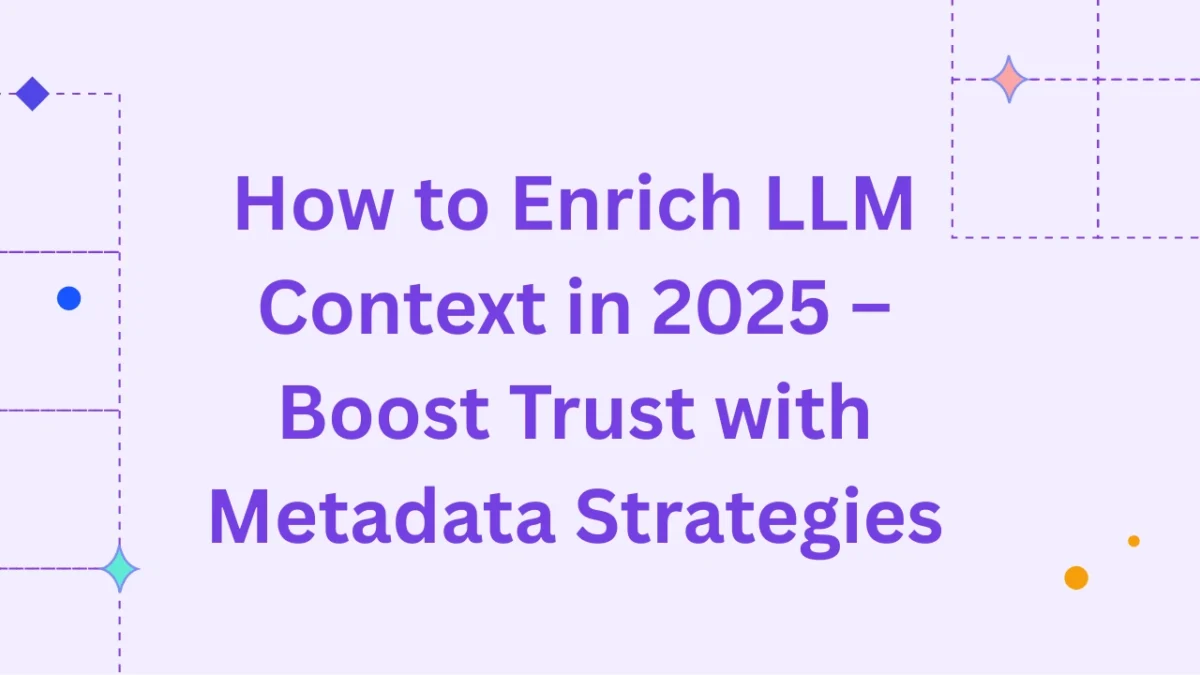In today’s fast-growing digital world, large language models (LLMs) have become powerful tools for generating meaningful text, assisting in research, and supporting business applications. However, the quality of their responses depends heavily on the context they are provided. Without sufficient or relevant context, even the most advanced model can deliver vague, inaccurate, or incomplete results.

This article explores how enriching context can significantly improve the capabilities of LLMs, why metadata matters, what methods can be applied, and how businesses and professionals can benefit.
Why Context is the Key to Better Performance
Context is not just about the words in a question or document. It includes background information such as who wrote the text, why it was written, when it was created, and who the audience is. Adding this extra layer of detail helps a model deliver answers that are more accurate, reliable, and tailored.
Key Notes:
- Context is crucial for accurate, relevant, and trustworthy responses.
- Metadata fields like author, purpose, and audience guide interpretation.
- Benefits include higher accuracy, better style control, and domain reliability.
- Challenges include token limits, irrelevant metadata, and extra effort.
- Businesses gain better customer support, marketing, and research outcomes.
- Best practices involve consistency, relevance, and balanced detail.
What Does Enriching Context Mean?
Enriching context involves supplying structured information alongside the main text to guide the model in interpreting and generating responses. Instead of only providing content, you also add details like:
- Provenance – Who wrote it and when.
- Purpose – The intent behind the text (inform, persuade, educate).
- Audience – The target readers (students, experts, general public).
- Tone and style – Formal, casual, persuasive, or technical.
- Topics and tags – Clear subject categories or keywords.
This extra information acts like a roadmap, helping the model avoid guesswork.
Read Also: Google Search Console Adds Achievements Report: A New Way to Track Your SEO Milestones
Benefits of Enriching Context
Adding context delivers significant advantages across multiple areas.
1. Improved Accuracy and Relevance
When the model understands not only the content but also the intent, it delivers answers that are directly aligned with user expectations.
2. Reduced Risk of Errors
Context helps prevent irrelevant or misleading responses, anchoring the model closer to the source material.
3. Better Style and Structure Control
When audience and tone are specified, the output can match the required style—whether it’s academic, professional, or casual.
4. Stronger Domain Applications
In fields like healthcare, law, or finance, enriched context ensures that outputs remain focused, precise, and trustworthy.
Practical Ways to Enrich Context
Different strategies can be applied depending on the task. Here are some proven methods:
Add Metadata Fields
Label important details such as:
- Source: Website, book, or document
- Date: Publication or update date
- Author: Individual or organization
- Intent: Explanation, instruction, or marketing
This simple step guides the model to interpret the text with higher clarity.
Read Also: Infinix’s New Smartphone: Bold Claims, Exciting Specs, and Questions You Should Ask
Use Structured Formats
Instead of writing long prompts, use clear sections:
Source: Medical Journal
Purpose: Explain treatment options
Audience: General public
Tone: Informative and easy to understand
Content: How to improve LLM accuracy
Filter and Select Relevant Metadata
Not all context is useful. Choose metadata that directly enhances understanding. For instance, in a product review, the date and reviewer’s expertise may matter more than word count.
Retrieval-Augmented Methods
Combine external sources with the text to ensure the model receives up-to-date, domain-specific information. This strengthens reliability in real-world use.
Challenges in Adding Context
While enriching context has clear advantages, it also brings certain challenges.
Token Limits
Models have a maximum capacity. Too much metadata may consume space, leaving less room for the main content.
Choosing What Matters
Not all metadata improves quality. Overloading with unnecessary details can cause confusion instead of clarity.
Standardization Issues
For best results, metadata should follow a consistent structure. Random or inconsistent formats reduce effectiveness.
Effort and Cost
Collecting metadata for large volumes of text requires planning and sometimes technical tools.
Why Metadata Matters for Businesses
Businesses relying on digital tools, research, or customer service can greatly benefit from context enrichment. Here’s how:
- Customer Support: Context such as customer history, location, and product details ensures accurate, personalized responses.
- Content Marketing: Adding target audience and tone metadata helps deliver content that resonates.
- Research and Reports: Provenance and tags make outputs more credible and easier to verify.
- E-commerce: Product descriptions enriched with structured data increase search engine visibility.
Key Notes:
- Metadata reduces risks in decision-making.
- Enriched responses save time and improve trust.
- Businesses gain a competitive edge by making digital tools more reliable.
The Role of Structured Prompts
One of the simplest yet most effective ways to enrich context is by designing structured prompts. Instead of writing vague instructions, breaking down input into labeled sections makes a huge difference.
For example:
Without context:
“Write about smartphones.”
With context:
“Source: Technology Blog
Purpose: Compare flagship smartphones
Audience: College students
Tone: Friendly and simple
Content: List of top smartphones from 2025.”
The second example ensures output is more relevant, audience-focused, and stylistically correct.
Read Also: Spectrum TV App Hits LG and VIZIO Smart TVs: Game-Changer
How Enriched Context Builds Trust
Trust is central to Google’s E-E-A-T framework. By adding details like author credibility, publication date, and intent, enriched context makes information more transparent and verifiable.
- Experience: Metadata shows the expertise behind content.
- Expertise: Clear intent highlights subject depth.
- Authoritativeness: Provenance points to reputable sources.
- Trustworthiness: Dates and references prevent outdated or misleading information.
Best Practices for Enriching Context
To make the most of this strategy, follow these guidelines:
- Keep Metadata Relevant – Only include information that truly helps interpretation.
- Stay Consistent – Use the same labels and structures across all prompts.
- Balance Detail and Brevity – Add enough context without overwhelming the main text.
- Update Regularly – Ensure metadata like publication dates remain current.
- Leverage Retrieval Systems – For complex tasks, combine metadata with external sources.
Future Outlook: Context as a Standard
As digital tools become more advanced, enriching context is likely to become a standard practice. Professionals, businesses, and researchers will adopt structured metadata to improve efficiency, reliability, and personalization.
In the near future, expect to see:
- Automated systems that generate metadata for documents.
- Industry-specific standards for contextual enrichment.
- Integration of enriched context in search, research, and customer support platforms.
Final Thoughts
Enriching context is not a complex technical upgrade—it’s a strategic approach that anyone can implement to unlock better results. By combining metadata, structured prompts, and retrieval methods, you can significantly improve the reliability and usefulness of digital tools.
For businesses, professionals, and researchers, enriched context is more than an improvement; it is a necessity for accuracy, credibility, and trust in a competitive digital world.



